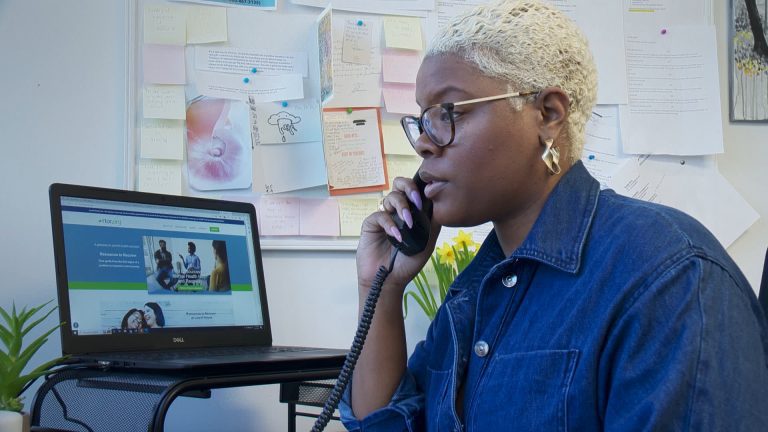Most of us have a general idea of what anxiety is – and perhaps you even know what it feels like.
But how would you know the difference between healthy, contextual anxiety (such as that anxiety you feel standing at the edge of a cliff looking down) versus anxiety that is maladaptive?
Anxiety is supposed to serve a purpose by helping us navigate dangerous situations (or people) and prepare adequately for significant events.
But for someone who has an anxious attachment style, anxiety doesn’t always serve them well. In real-world situations, it often has the opposite effect on our relationships, causing us to push people away and sabotage otherwise great connections.
How Is Anxious Attachment Formed?
An anxious attachment style is formed due to inconsistent and unreliable responsiveness from your mother and father when you cried or sought connection as a baby.
As babies, we all cry. And if our mother and father can, they immediately pick us up and soothe or feed us. This hyper-responsiveness and nurturing from parents allows us to gain a secure attachment style.
But if your parents didn’t offer timely, reliable responsiveness to your cries, your nervous system shaped itself for this environment.
You may wonder, what environment exactly? An environment where nurturing and bonding weren’t reliably available when you needed it.
Thus, your nervous system learns early on in life that it cannot actually relax if you are ever going to get the love and bonding you need. Instead, it learns to stay in an overactive state, subjecting you to chronic stress and anxiety.
Unlike those with a secure attachment style, it operates on the knowledge that you don’t live in an environment where people are there when you need them. Your nervous system functions on programming that tells you attachment is not safe.
As a baby, you would have learned to deal with this by escalating your cries for attention for as long as you need to, and this distress leaves a lasting imprint on your attachment system.
Your attachment system believes at its core that constant stress is the only way to get the bonding you need.
If, like roughly 20% of the population, you have an anxious attachment style, you will take this attachment style into your adult relationships, especially your romantic relationships.
If you are unsure of what your core attachment style is, here is a quiz you can take to determine it.
Next, we’ll look at 3 signs you have an anxious attachment style and how to become securely attached (it’s not an overnight process, but it is possible).
#1: You Struggle Trusting Your Partner In a Relationship
…Even if you have no reason not to trust them.
It doesn’t matter how many times your lover or partner reassures you that they will not abandon you or cheat on you—deep down, you don’t believe it’s true.
But why? Why wouldn’t you trust a partner of integrity and good character?
Because your nervous system dictates that it’s essentially your job not to trust them. In creating this tension of distrust, you believe you are doing a good thing for the relationship. You believe this anxiousness is what will keep them around.
It’s kind of like your body pre-emptively distrusts your partner because your attachment system tells you that high stress is the only way to secure any kind of attachment and love.
See how this can be not only maladaptive but also self-sabotaging?
#2: You Feel Deep Shame Around Your Need for Intimacy
This is one part about anxious attachment that even those who know they have anxious attachment don’t like talking about.
When we are born, our parents (or caregivers) are entrusted to take care of us. As vulnerable, helpless babies, we are at the mercy of their treatment.
What a lot of parents aren’t aware of is that if they reliably respond to their baby’s cries, they are teaching their baby to trust relationships. More importantly, they are teaching their baby that they are worthy of love and attachment.
However, if our parents couldn’t get to us reliably (perhaps they had other stressors in their lives), we learn to harbor a deep fear that we are unworthy of attachment and loyalty.
We also learn that having very natural needs like intimacy and closeness is shameful (because our needs were a burden that couldn’t be satisfied).
As Robert Karen, PhD, author of “Becoming Attached” would say, “ugly needs, ugly me.”
#3: You Feel Jealous – A Lot.
Every anxiously attached person is painfully familiar with jealousy. It’s the emotion that they hate but can’t help feeling.
Why is this?
It’s because anxious individuals are hyper-sensitive to any possible threat to their relationship.
Remember how I said that an anxious person has an overactive nervous system?
When you’re anxiously attached, you always feel the need to guard your relationship, even when the threats are just imaginary. This is your anxious attachment pattern overcompensating for the lack of attunement to your needs as a baby.
Going to the extreme of all emotions is the only way you know how to have your needs met – and the hope to feel safe inside of a relationship.
#4: You Sabotage Relationships
Remember when we discussed how your nervous system learned that tension is its default state?
Well, your body is always swinging the pendulum from distrust to deeply craving intimacy. Thus, you eventually sabotage great connections simply because you can’t sustain the constant anxiety.
At some point, you get tired of tuning into every imagined threat and feeling that you must try so hard just to be worthy of love, so you sabotage.
Unlike a securely attached person with a calibrated nervous system who welcomes intimacy and warmth all the time, you are constantly wrestling with this fear that you’re not worthy of it.
Even when you are open to intimacy, you still have to face shame. And that gets tiring. Thus, you subconsciously choose to sabotage and keep people at arm’s length due to your lack of skills or knowledge to consciously choose intimacy.
How to Heal Anxious Attachment and Become Secure?
These signs beg the question: how do you heal and gain “earned secure attachment?”
Here are two steps:
#1: Practice Physical Closeness Every Day
You heard me right. Practice physical closeness every day. This could mean ensuring you’re never the first to pull away from the hug.
It could also mean just making a point to hug your child, lover, or family member every day to force your nervous system to choose intimacy.
#2: Recognize Your Triggers and Breathe Through Them
People with anxious attachment patterns have to grapple with many triggers almost every day. Click here to read 12 of them.
You need to recognize when you’re getting triggered to go into panic mode and consciously choose to calm your nervous system down.
How do you do that?
You can choose from a few options:
- Practice deep breathing
- Listen to a song that reliably calms you down and puts you in a calm state (keep it handy on your phone)
- Meditate
- Use nurturing affirmations to reassure yourself. For example: “I am worthy of love. I always was.”
Final Words
Dealing with anxious attachment patterns is never easy, not in the least, because as an adult, the responsibility is now all upon yourself.
But when the alternative is a life of constant stress for you and everyone close to you, isn’t the effort worth it?
I’d argue yes, absolutely.
About the Author: Renée Wade is the founder of The Feminine Woman & co-founder of Shen Wade Media, where she teaches women how to overcome insecure attachment and inspire a deep emotional commitment from their chosen man. She graduated with a bachelor of Law and Bachelor of Arts, majoring in sociology and minoring in psychology. She has been a dating and relationship coach for women for the past 15 years and has positively influenced the lives of over 20 million women through her work.
Photo by Liza Summer: https://www.pexels.com/photo/anxious-woman-touching-head-while-looking-at-crop-female-during-argument-6382706/
The opinions and views expressed in any guest blog post do not necessarily reflect those of www.rtor.org or its sponsor, Laurel House, Inc. The author and www.rtor.org have no affiliations with any products or services mentioned in the article or linked to therein. Guest Authors may have affiliations to products mentioned or linked to in their author bios.
Recommended for You
- The Truth about Relapse in Addiction Recovery - April 14, 2025
- The Power of Peer Support in Mental Health Recovery - April 10, 2025
- Artificial Intelligence in Anxiety Management: How AI Helps Users Cope with Anxiety Symptoms - April 3, 2025







